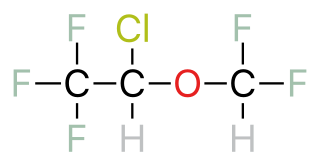Related Research Articles
General anaesthetics are often defined as compounds that induce a loss of consciousness in humans or loss of righting reflex in animals. Clinical definitions are also extended to include an induced coma that causes lack of awareness to painful stimuli, sufficient to facilitate surgical applications in clinical and veterinary practice. General anaesthetics do not act as analgesics and should also not be confused with sedatives. General anaesthetics are a structurally diverse group of compounds whose mechanisms encompasses multiple biological targets involved in the control of neuronal pathways. The precise workings are the subject of some debate and ongoing research.

Inhalants are a broad range of household and industrial chemicals whose volatile vapors or pressurized gases can be concentrated and breathed in via the nose or mouth to produce intoxication, in a manner not intended by the manufacturer. They are inhaled at room temperature through volatilization or from a pressurized container, and do not include drugs that are sniffed after burning or heating. For example, amyl nitrite (poppers), nitrous oxide and toluene – a solvent widely used in contact cement, permanent markers, and certain types of glue – are considered inhalants, but smoking tobacco, cannabis, and crack are not, even though these drugs are inhaled as smoke or vapor.

Narcosis while diving is a reversible alteration in consciousness that occurs while diving at depth. It is caused by the anesthetic effect of certain gases at high pressure. The Greek word νάρκωσις (narkōsis), "the act of making numb", is derived from νάρκη (narkē), "numbness, torpor", a term used by Homer and Hippocrates. Narcosis produces a state similar to drunkenness, or nitrous oxide inhalation. It can occur during shallow dives, but does not usually become noticeable at depths less than 30 meters (100 ft).

Nitrous oxide, commonly known as laughing gas, nitrous, or nos, is a chemical compound, an oxide of nitrogen with the formula N
2O. At room temperature, it is a colourless non-flammable gas, and has a slightly sweet scent and taste. At elevated temperatures, nitrous oxide is a powerful oxidiser similar to molecular oxygen.

Halothane, sold under the brand name Fluothane among others, is a general anaesthetic. It can be used to induce or maintain anaesthesia. One of its benefits is that it does not increase the production of saliva, which can be particularly useful in those who are difficult to intubate. It is given by inhalation.

Isoflurane, sold under the brand name Forane among others, is a general anesthetic. It can be used to start or maintain anesthesia; however, other medications are often used to start anesthesia rather than isoflurane, due to airway irritation with isoflurane. Isoflurane is given via inhalation.

An anesthetic or anaesthetic is a drug used to induce anesthesia — in other words, to result in a temporary loss of sensation or awareness. They may be divided into two broad classes: general anesthetics, which result in a reversible loss of consciousness, and local anesthetics, which cause a reversible loss of sensation for a limited region of the body without necessarily affecting consciousness.

Desflurane (1,2,2,2-tetrafluoroethyl difluoromethyl ether) is a highly fluorinated methyl ethyl ether used for maintenance of general anesthesia. Like halothane, enflurane, and isoflurane, it is a racemic mixture of (R) and (S) optical isomers (enantiomers). Together with sevoflurane, it is gradually replacing isoflurane for human use, except in economically undeveloped areas, where its high cost precludes its use. It has the most rapid onset and offset of the volatile anesthetic drugs used for general anesthesia due to its low solubility in blood.

Nitrous oxide, is an inhaled gas used as a pain medication and together with other medications for anesthesia. Common uses include during childbirth, following trauma, and as part of end-of-life care. Onset of effect is typically within half a minute, and the effect lasts for about a minute.

An inhalational anesthetic is a chemical compound possessing general anesthetic properties that can be delivered via inhalation. They are administered through a face mask, laryngeal mask airway or tracheal tube connected to an anesthetic vaporiser and an anesthetic delivery system. Agents of significant contemporary clinical interest include volatile anesthetic agents such as isoflurane, sevoflurane and desflurane, as well as certain anesthetic gases such as nitrous oxide and xenon.

A halogenated ether is a subcategory of a larger group of chemicals known as ethers. An ether is an organic chemical that contains an ether group—an oxygen atom connected to two (substituted) alkyl groups. A good example of an ether is the solvent diethyl ether.
Minimum alveolar concentration or MAC is the concentration, often expressed as a percentage by volume, of a vapour in the alveoli of the lungs that is needed to prevent movement in 50% of subjects in response to surgical (pain) stimulus. MAC is used to compare the strengths, or potency, of anaesthetic vapours. The concept of MAC was first introduced in 1965.

Methoxyflurane, sold under the brand name Penthrox among others, is an inhaled medication primarily used to reduce pain following trauma. It may also be used for short episodes of pain as a result of medical procedures. Onset of pain relief is rapid and of a short duration. Use is only recommended with direct medical supervision.
During induction of general anesthesia, when a large volume of a gas is taken up from alveoli into pulmonary capillary blood, the concentration of gases remaining in the alveoli is increased. This results in effects known as the "concentration effect" and the second gas effect. These effects occur because of the contraction of alveolar volume associated with the uptake of the nitrous oxide. Previous explanations by Edmond I. Eger and Robert K. Stoelting have appealed to an extra-inspired tidal volume due to a potential negative intrapulmonary pressure associated with the uptake of the nitrous oxide.
Dental anesthesia is the application of anesthesia to dentistry. It includes local anesthetics, sedation, and general anesthesia.
The Fink effect, also known as "diffusion anoxia", "diffusion hypoxia", or the "second gas effect", is a factor that influences the pO2 (partial pressure of oxygen) within the pulmonary alveoli. When water-soluble gases such as anesthetic agent N2O (nitrous oxide) are breathed in large quantities they can be dissolved in body fluids rapidly. This leads to a temporary increase in both the concentrations and partial pressures of oxygen and carbon dioxide in the alveoli.
Blood–gas partition coefficient, also known as Ostwald coefficient for blood–gas, is a term used in pharmacology to describe the solubility of inhaled general anesthetics in blood. According to Henry's law, the ratio of the concentration in blood to the concentration in gas that is in contact with that blood, when the partial pressure in both compartments is equal, is nearly constant at sufficiently low concentrations. The partition coefficient is defined as this ratio and, therefore, has no units. The concentration of the anesthetic in blood includes the portion that is undissolved in plasma and the portion that is dissolved. The more soluble the inhaled anesthetic is in blood compared to in air, the more it binds to plasma proteins in the blood and the higher the blood–gas partition coefficient.

Nitrogen dioxide poisoning is the illness resulting from the toxic effect of nitrogen dioxide. It usually occurs after the inhalation of the gas beyond the threshold limit value. Nitrogen dioxide is reddish-brown with a very harsh smell at high concentrations, at lower concentrations it is colorless but may still have a harsh odour. Nitrogen dioxide poisoning depends on the duration, frequency, and intensity of exposure.

Inhalation sedation is a form of conscious sedation where an inhaled drug should:
- Depress the central nervous system (CNS) to an extent that surgeons can operate with minimal physiological and psychological stress to the patient
- Modify the patient's state of mind such that communication is maintained and the patient can respond to verbal command
- Carry a margin of safety wide enough to render the unintended loss of consciousness and loss of protective reflexes unlikely.

Robert Marvin Epstein is an American anesthesiologist, a member of the National Academy of Medicine, and the Harold Carron Professor of Anesthesiology (emeritus) at the University of Virginia.
References
- Korman B, Mapleson WW (May 1997). "Concentration and second gas effects: can the accepted explanation be improved?". Br J Anaesth. 78 (5): 618–25. doi: 10.1093/bja/78.5.618 . PMID 9175984.
- Taheri S, Eger EI 2nd (September 1999). "A Demonstration of the Concentration and Second Gas Effects in Humans Anesthetized with Nitrous Oxide and Desflurane". Anesthesia and Analgesia. 89 (3): 774–80. doi: 10.1213/00000539-199909000-00047 . PMID 10475324.